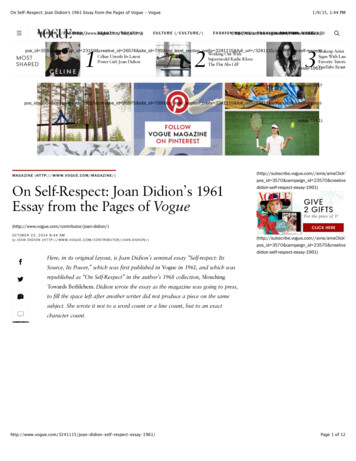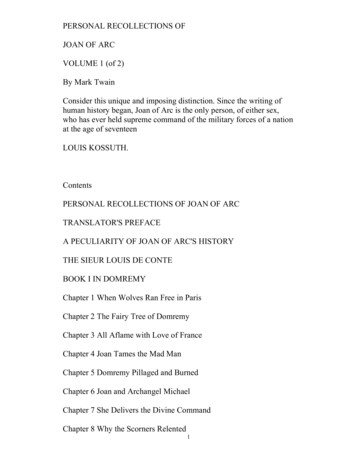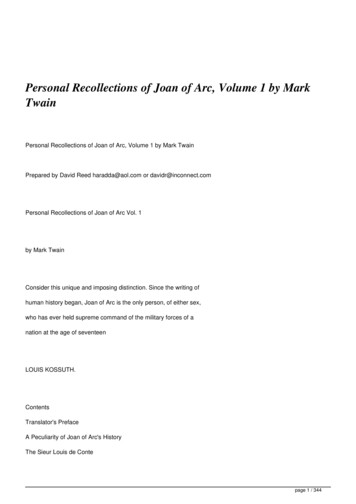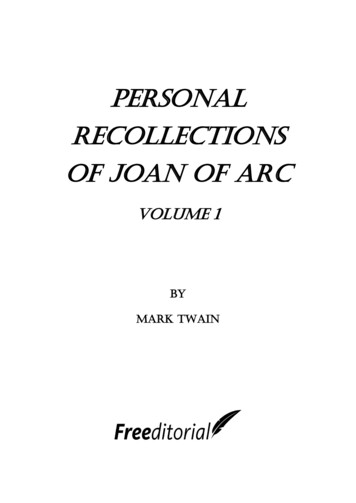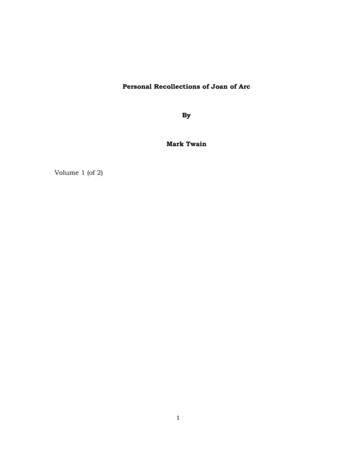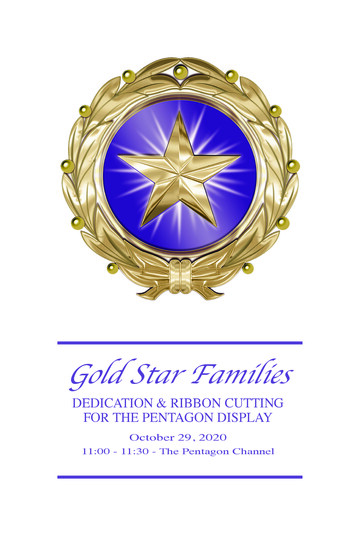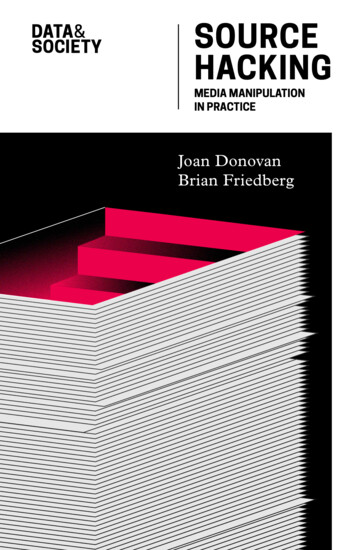
Transcription
SOURCEHACKINGMEDIA MANIPULATIONIN PRACTICEJoan DonovanBrian Friedberg
Author: Joan Donovan; Director of the Technology andSocial Change Research Project, Harvard Kennedy School,PhD, 2015, Sociology and Science Studies, University ofCalifornia San Diego.Author: Brian Friedberg; Senior Researcher, Technology andSocial Change Research Project, Harvard Kennedy School;MA, 2010, Cultural Production, Brandeis University.This report is published under Data & Society’s MediaManipulation research initiative; for more information onthe initiative, including focus areas, researchers, andfunders, please visit n
-1-SOURCE HACKINGCONTENTS02 Executive Summary04 Introduction06 What is Source Hacking?09 1. Viral Sloganeering09Case Study: Jobs Not Mobs12Case Study: It's OK To Be White18 2. Leak Forgery19Case Study: The Waters Leak21Case Study: The Macron Leak26 3. Evidence Collages28Case Study: Charlottesville Unite the Right Rally31Case Study: Pizzagate37 4. Keyword Squatting38Case Study: Antifa Social Media Accounts42Case Study: Internet Research Agency46 Conclusion50 Appendix 1: Source Hacking Threat Model53 Acknowledgments
DATA & SOCIETYEXECUTIVE SUMMARYIn recent years there has been an increasing number ofonline manipulation campaigns targeted at newsmedia. This report focuses on a subset of manipulationcampaigns that rely on a strategy we call source hacking:a set of techniques for hiding the sources of problematicinformation in order to permit its circulation in mainstream media. Source hacking is therefore an indirectmethod for targeting journalists—planting false information in places that journalists are likely to encounter it orwhere it will be taken up by other intermediaries.Across eight case studies, we identify the underlyingtechniques of source hacking to provide journalists,news organizations, platform companies, andothers with a new vocabulary for describing thesetactics, so that terms such as “trolling” and “trending”do not stand in for concerted efforts to pollute theinformation environment. In this report, we identify fourspecific techniques of source hacking:1.Viral Sloganeering: repackaging reactionarytalking points for social media and press amplification2.Leak Forgery: prompting a media spectacle bysharing forged documents3.Evidence Collages: compiling informationfrom multiple sources into a single, shareabledocument, usually as an image4.Keyword Squatting: the strategic dominationof keywords and sockpuppet accounts to misrepresent groups or individualsThese four tactics of source hacking work because networked communication is vulnerable to many differentstyles of attack and finding proof of coordination is noteasy to detect. Source hacking techniques complement-2-
SOURCE HACKINGeach other and are often used simultaneously duringactive manipulation campaigns. These techniques may becarefully coordinated but often rely on partisan supportand buy-in from audiences, influencers, and journalistsalike.We illustrate these techniques with case studies takenfrom 2016–2018, and with a specific focus on themanipulation of American politics. We end by offering aset of suggestions and new concepts for those attemptingto identify the operations of manipulation campaigns orto respond to breaking news events: We advise journalists to seek out an abundanceof corroborating evidence when reportingon the actions of social media accounts, andwhenever possible, verify the identity of accountholders. We suggest that newsrooms invest moreresources in information security, includingcreating a position or desk to vet chains ofevidence through analysis and verification ofmetadata for evidence of data craft. We argue that platform companies mustlabel manipulation campaigns when theyare identified and provide easier access tometadata associated with accounts.-3-
-4-DATA & SOCIETYINTRODUCTIONIn recent years, there has been an increasing number ofonline manipulation campaigns targeted at news media. The goals of manipulation campaigns can vary widely,but they all rely on communication platforms to respondin real time to breaking “media spectacles” or, sometimes,to anticipate or even generate such spectacles. This reportfocuses on a subset of manipulation campaigns that relyon a strategy we call source hacking. Source hacking isa set of techniques for hiding the sources of problematicinformation in order to permit its circulation in mainstream media. Source hacking is therefore an indirectmethod for targeting journalists—planting false information in places that journalists are likely to encounter it, orwhere it will be taken up by other intermediaries.121Douglas Kellner, Media Spectacle (London; New York: Routledge, 2003).2The concept of cloaked websites, which operate like phishing campaigns,originates with research related to white supremacists’ use of the internet. See: Jessie Daniels, Cyber Racism: White Supremacy Online and theNew Attack on Civil Rights (Lanham, Md: Rowman & Littlefield Publishers,2009). Md: Rowman & Littlefield Publishers, 2009.
-5-SOURCE HACKINGIn this report, we identify four specific techniques ofsource hacking: viral sloganeering, leak forgery, evidence collaging, and keyword squatting. Using thesecategories to describe the work of manipulation campaigns can increase the specificity with which we trackmedia manipulation. We illustrate these techniques withcase studies taken from 2016–2018, and with a specificfocus on the manipulation of American politics. We endby offering a set of suggestions and new concepts forthose attempting to identify the operations of manipulation campaigns or to respond to breaking news events.343Media manipulation campaigns are drawn from the local political opportunities aided by the organization of the state, technology companies, andnews media. We do not know the extent to which the tactics we observetranslate into other contexts. For grounded empirical investigations, werecommend the following research: India (Chaturvedi, Swati. 2016. I Ama Troll: Inside the Secret World of the BJP’s Digital Army. New Delhi, India:Juggernaut Publication). Philippines (Ong, J. C., and J. V. A. Cabanes. 2018.“Architects of Networked Disinformation: Behind the Scenes of Troll Accounts and Fake News Production in the Philippines.” Monograph. February9, 2018. EPORT.pdf.), Russia,(Pomerantsev, Peter. 2015. Nothing Is True and Everything Is Possible: TheSurreal Heart of the New Russia. Reprint edition. PublicAffairs.), Mexico(Rosa, Raúl Magallón. 2019. UnfakingNews: Cómo combatir la desinformación. Edición: edición. Grupo Anaya Publicaciones Generales).4We acknowledge the potential impact of amplifying manipulation effortsthrough research. Scholars Ryan Millner and Whitney Phillips have exploredthe ways in which granting additional “oxygen” to these actors helpsspread their message. While identifying proven techniques of mediamanipulators, we avoid providing insight into how manipulation could bedone more effectively. Additionally, we are not attempting to highlightindividual manipulators or grant them platforms. Instead, this documentprovides a historical context for future manipulation campaigns and recommendations for reporting on extremism. See: Ryan Milner, “Hacking theSocial: Internet Memes, Identity Antagonism, and the Logic of Lulz,” TheFibreculture Journal, no. 22 (2013), sm-andthe-logic-of-lulz/; Whitney Phillips, “The Oxygen of Amplifcation: BetterPractices for Reporting on Extremists, Antagonists, and ManipulatorsOnline” (New York: Data & Society Research Institute, May 2018).
-6-DATA & SOCIETYWHAT ISSOURCE HACKING?Source hacking is a versatile set of techniques for feedingfalse information to journalists, investigators, and thegeneral public during breaking news events or acrosshighly polarized wedge issues. Specifically, source hacking exploits situations and technologies to obscure theauthorship of false claims. Across eight case studies, weidentify the underlying techniques of source hacking toprovide journalists, news organizations, platform companies, and others with a new vocabulary for describingthese tactics, so that terms such as “trolling” and “trending” do not stand in for concerted efforts to pollute theinformation environment.5Manipulators must be skillful content creators, adept atcreating persuasive audiovisual materials in time-sensitivescenarios. Persuasive memes, convincing fake articles,and heavily edited video are common media spreadduring a manipulation campaign. Content is oftenworkshopped in private communications or on forums.Merging the techniques of marketing and political propaganda, successful source hacking materials are persuasivetext, images, or video that do not require a legitimateauthor to establish authenticity.Manipulators demonstrate skill both in the craftingof a message and the metadata of the objects used as5Wedge issues are contested politicized positions around identity,authority, and justice, often centered on the distribution of rights andrepresentation. The support for, and media representation of, civil rightsorganizing has historically been a wedge issue in the United States. See,for instance: Gyung-Ho Jeong et al., “Cracks in the Opposition: Immigrationas a Wedge Issue for the Reagan Coalition,” American Journal of PoliticalScience 55, no. 3 (2011): 511–25.
-7-SOURCE HACKINGevidence. Data craft, as defined by Amelia Acker (2018),is a set of practices that “create, rely, or even play withthe proliferation of data on social media by engagingwith new computational and algorithmic mechanismsof organization and classification.” Media manipulatorscreate campaign materials with knowledge of technological and cultural vulnerabilities, taking advantage ofplatform design to amplify persuasive content. Carefulattention to data craft is the foundation of a successfulmanipulation campaign, as manipulators create images, videos, and documents, carefully working aroundsystems like spam detection, circumventing platformcompanies’ terms of service and trust and safety teams.Individual actors use sockpuppet accounts, botnets, andsocial media influencers to create trending opportunities and saturate hashtags with original content. Carefuldata crafting allows manipulators to create forgeries thatappear legitimate and original, obscuring their originswith appeals to authenticity and using metrics as a formof legitimation.67The following section presents eight case studies of manipulation campaigns from 2016–2018. These campaignsvary in many ways. Some were quick responses to breaking news coverage, while others were deliberate attemptsto create new coverage. Some events, like “It’s OK To BeWhite,” were particularly campaign-like and involved thecareful design of a slogan by a small number of manipulators. Others, like Pizzagate, may have had periods ofcampaign-like organization, but were also the result oflong, messy collaboration across platforms and groups.Despite these differences, all of these campaigns reliedon some form of source hacking. That is, the campaigns’6Amelia Acker, “Data Craft” (Data & Society Research Institute, November5, 2018), https://datasociety.net/output/data-craft/.7Acker developed an eight-step chart for spotting manipulation on socialmedia that all journalists, researchers, and technologists can use to identify red flags. See: /DS Data Craft Manipulation of Social Media Metadata Infographic2.pdf.
DATA & SOCIETYsuccess relied specifically on hiding the real sources ofinformation from an eventual mainstream audience.The four techniques of source hacking we identify are:1.Viral Sloganeering: repackaging reactionarytalking points for social media and pressamplification2.Leak Forgery: prompting a media spectacle bysharing forged documents3.Evidence Collages: compiling information frommultiple sources into a single, shareabledocument, usually as an image4.Keyword Squatting: the strategic domination ofkeywords and sockpuppet accounts to misrepresent groups or individuals-8-
SOURCE HACKING1. VIRAL SLOGANEERINGCASE STUDIES:- Jobs Not Mobs- It’s OK To Be WhiteViral sloganeering is a process of crafting divisive culturalor political messages in the form of short slogans and propagating these (both online and offline) in an effort to influenceviewers, force media coverage, and provoke institutionalresponses. Sometimes, manipulators choose viral slogansthat attempt to co-opt an existing controversy or newstopic. Other times, manipulators will attempt to fill “datavoids” —combinations of terms or search queries withlittle existing content, which can be easily associated withpolitical messaging. Viral slogans can be spread throughmemes, hashtags, posters, and videos. Most importantly,because these forms are easily transmitted and copied,they can quickly spread to public forums, both onlineand off, and thus become far removed from the groupthat created them. If manipulators are able to hide thesource of the slogan and create sufficient social mediacirculation, mainstream media sources may provide evenfurther amplification.8Jobs Not MobsIn October 2018, the viral slogan “Jobs Not Mobs” movedfrom online fringes to national attention, where it waseventually adopted by President Trump. A November2018 investigation by the New York Times details how this8Michael Golebiewski and danah boyd, “Data Voids: Where Missing DataCan Easily Be Exploited” (Data & Society Research Institute, May ere-missing-data-can-easilybe-exploited/.-9-
- 10 -DATA & SOCIETYphrase moved from anonymous social media users to apresidential slogan within a few weeks, highlighting thesignificant Twitter, Reddit, and Facebook activity generated by those involved. By exploiting immigration asa partisan wedge issue and using social media, manipulators effectively mainstreamed a far-right talking pointthat alleges their opposition is violent and irrational.9Jobs Not Mobs meme from subreddit r thedonald, Friday, October 12, 2018.10In recent years it has become commonplace for rightwing pundits to use the term “mob” to refer to (and9Keith Collins and Kevin Roose, “Tracing a Meme From the Internet’s Fringeto a Republican Slogan,” The New York Times, November 4, 2018, sec. Technology, hnology/jobs-not-mobs.html, m/r/The Donald/comments/9nq3kp/jobs not mobs/.
- 11 -SOURCE HACKINGdiscredit) their political opponents: anti-fascist and otherleft-leaning protests, as well as groups of refugees or immigrants. This rhetorical strategy occurs both in fringesocial media circles and mainstream media outlets suchas Fox News. In 2018, Twitter users began using “mobs”in configurations of a viral slogan: “Jobs Not Mobs.”11While social media posts iterating jobs and mobs organically caught on among right and far-right influencers, thephrase experienced a jump in popularity after a grouporganized on Reddit took special steps to craft new mediadisseminating and formalizing the slogan. On Reddit,users workshopped memes to spread on social media.Video clips were created, showing decontextualized turmoilat rallies and supposed migrant caravans, serving asvisual reinforcement of the “mobs” claim. Easily shareableaudiovisual material, alongside the deployment of ahashtag, created opportunities for a swarm of participation, and the slogan quickly grew past its point of originin far-right online hubs like Reddit’s the donald. Whilethe campaign gained organic traction among nationalistcommunities in the US, significant bot activity has beenidentified in the spread of the slogan on Twitter.12The slogan circulated on several small right-wing newsplatforms, drawing support from major right-wingsocial media influencers. Then, in a tweet on October21, 2018, president Trump himself used the hashtag“#JOBSNOTMOBS!” along with an embedded videotaken, without attribution, from YouTube. Popular pressquickly reacted to Trump’s adaptation of the slogan.1311Dan Gainor, “Media Pretend Left-Wing Mobs of Protesters Aren’t ReallyMobs,” Text.Article, Fox News, October 13, 2018, -wing-mobs-of-protesters-arent-reallymobs.12See: https://botsentinel.com/tweet-archive?s jobsnotmobs.13Sophie Weiner, “Trump’s ‘Jobs Not Mobs’ Video Was Taken From an Anonymous GOP Fan,” Splinter, November 2, 2018, ideo-trump-tweeted-was-taken-f-1830171490.
- 12 -DATA & SOCIETYA subsequent Fox News segment entitled “‘Jobs notmobs’ Trump unveils new midterm message,” effectivelymarking this slogan as an official statement, exposing itto mainstream TV audiences and reinforcing its effectiveness among the communities that helped spread itonline.14It’s OK To Be White15“It’s Okay to Be White” (IOTBW) was a viral slogandesigned to capture the narrative around contemporaryrepresentations of white supremacy and identity, adoptedand popularized by a variety of reactionary communities.Drawing on the popularity of the Black Lives Mattermovement, this campaign sought to use racism as a wedgeissue to polarize media attention to white identity politics.The first instructions for the campaign were posted onOctober 24, 2017, to 4chan’s right wing /pol/ board byan anonymous author, loosely outlining a plan to placesimple black-and-white flyers with the titular phrase oncollege campuses. The campaign instructions presumedan audience of high school and university students. Someof the manipulators involved set their media strategy ininstructional images (see below). These images read likesomething out of a style guide, specifying that the flyersmust not contain any additional advertisement for whitesupremacist groups, websites, or communities, thusobscuring their place of origin and attributing no authorship. These posts proliferated on 4chan before moving onto other forums and social media. The simple instructionscaught on over the next few days, and additional flyercampaigns were largely coordinated using 4chan andDiscord, a messaging app originally designed for gaming1614“‘Jobs Not Mobs’: Trump Unveils New Midterm Message,” Fox News,accessed May 21, 2019, http://video.foxnews.com/v/5852648609001/.15This case study was co-authored by Becca 24824/#146542738.
- 13 -SOURCE HACKINGcommunities.17IOTBW instructions spread across 4chan, Stormfront, and Reddit. 18As individuals began hanging up actual IOTBW posters,a growing number of posts appeared on forums with images of the posters hung on college campuses and otherpublic spaces, serving as motivational encouragementfor other participants in the campaign. Waves of flyersin public spaces were deployed by an unknown numberof individuals during times of high youth activity in late2017 and 2018, like Halloween or the beginning of theschool year.192017April Glaser, “White Supremacists Still Have a Safe Space Online. It’sDiscord.,” Slate Magazine, October 9, 2018, lebs.org/pol/thread/148236228/.19Janell Ross, “‘It’s Okay to Be White’ Signs and Stickers Appear on Campuses and Streets across the Country,” Washington Post, November 3, 2017,sec. Post Nation, y/.20Caitlin Byrd, “Racist Flyers Keep Appearing on South Carolina CollegeCampuses; Experts Expect More to Come,” Post and Courier, February 25,2018, ses-experts/article 3188f0ee1742-11e8-88b5-e35653c04c82.html.
- 14 -DATA & SOCIETYThe anonymous placement of flyers in schools anduniversities was accompanied by simple social mediaposts spreading the same message, often using hashtagslike #ItsOkayToBeWhite and #IOTBW. In many cases,the flyers had their intended effect—members of thepublic reacted negatively to the signs, decrying themas racist. This reaction led to a number of institutionalresponses on college campuses and, eventually, newscoverage. This coverage began at low-level student pressand small regional journalism outlets. The participantsof IOTBW then collected, archived, and amplified thislow-level press, lauding it as further evidence of thecampaign’s success. Online influencers stepped into thecampaign and monetized it, such as Milo Yiannopoulos’selling IOTBW shirts on his college campus tour. Thispreceded the slogan’s jump to the mainstream press.21The mainstream coverage of IOTBW was only possiblebecause of the steps taken by participants to obscure theexplicitly white supremacist character of the campaign’sorigin. The source was often identified as those who tookpictures of the flyers in public space. More mainstreamfar-right and reactionary communities were able torally around the statement as a counter-point to “BlackLives Matter.” At the onset of the campaign in October2017, one 4chan poster stated in an instructional thread“Based on past media response to similar messaging,we expect the anti-white media to produce a shit-stormabout these racist, hateful, bigoted fliers with a completely innocuous message.” And indeed, as coverageof the posters grew, these manipulators continued to callfor public attention to white identity politics, or as theyreferred to it “anti-white racism.”2221Taryn Finley, “‘It’s Okay To Be White’ Signs Appear In Schools, Cities AcrossThe U.S.,” HuffPost, November 7, 2017, e-signs n org/pol/thread/146642618/#146643305.
- 15 -SOURCE HACKINGGroups of IOBTW manipulators communicated, at leastto each other, that the split of critical and sympatheticmainstream press coverage had always been a goal of thecampaign. Press coverage of the posters moved fromalternate influencers on YouTube and local newspapersto larger outlets such as The Washington Post, The BostonGlobe, and The Daily Caller. Each of those three outletscovered both the existence of the posters in physicalspaces, as well as the source of the campaign. The DailyCaller referenced an online forum, while both The BostonGlobe and The Washington Post specifically identified4chan. In contrast to this coverage, one Fox News commentator picked up the story but adopted the preferredframe of the manipulators, focusing on the “liberaloutrage” against IOTBW posters during a broadcast onNovember 3, 2017. Crucially, though, this particularFox News broadcast never made the link to 4chan orthe white supremacist rhetoric involved in the campaign’sorigin. On 4chan itself, as the segment aired, anonymoususers posted all-caps utterances like “HES SAYING IT,IT”S OKAY TO BE WHITE, HES DOING IT” and“OH SHIT HE'S GONNA COVER IOTBW.” Themedia coverage even had legislative consequences: theAustralian parliament was also forced to address theslogan in October 2018, when a member proposed ad/152182782/#152182782.24Ross, “’It’s Okay to be White.’”25Carrie Blazina and Alyssa Meyers, “Stickers Saying ‘It’s Okay to Be White’Posted in Cambridge,” BostonGlobe.com, November 1, 2017, 4Ka5nbOgHK/story.html.26Michael Bastasch, “‘It’s Okay To Be White’ Stickers Posted AroundCollege Town,” The Daily Caller, November 1, 2017, 19.
- 16 -DATA & SOCIETYslogan in a motion to condemn “anti-white racism.” Bythe measures set out in the initial directions, IOTBWwas a huge success for the manipulators.28ConclusionThe consistent use of viral sloganeering, phrases thatmove from anonymous posts online to mainstreamtalking points, are expected from manipulators usingsmall news organizations and social media influencers asopportunities to frame new media spectacles. #IOTBWand #JobsNotMobs were in essence bottom-up anonymous operations, with public figures willfully orignorantly obscuring the materials’ origins in fringeonline communities. By developing the attention aroundthese slogans in authorless, anonymous, and informalsettings, manipulators can pre-empt the risk thatpublic figures might take on by supporting the slogansdeveloped explicitly by white supremacists. Pundits,newscasters, and politicians addressed these sloganswell after they’d been laundered by more public figuresthat report on, and participate in, conspiracies andmanipulation campaigns. For example, some socialmedia influencers are popular because they both spreadconspiracy theories and then report on the uptake andrefutation of those hoaxes, such is the case with punditslike Cassandra Fairbanks, Milo Yiannopoulos, and Mike2928Alan Pyke, “Australia Comes within 2 Votes of Endorsing 4chan-CoinedWhite Victimhood Meme as National Policy,” October 15, 2018, -resolution-senate-4chan900a4bb7f92a/.29Tyler Bridges, “‘Alt-Lite’ Bloggers and the Conservative Ecosystem,”February 20, 2018, nservative-ecosystem/; Kenneth P. Vogel, Scott Shane, and PatrickKingsley, “How Vilification of George Soros Moved From the Fringes to theMainstream,” The New York Times, November 2, 2018, sec. U.S., rge-soros-bombs-trump.html.
SOURCE HACKINGCernovich. And yet, once these slogans have beenwidely circulated and adopted, that dilution into thegeneral social media ecosystem masks their original,manipulative intent.30RecommendationsViral slogans often depend on specific influencers to beamplified, especially in instances where manipulatorsare seeding far-right, conspiratorial, and reactionarycontent. It is incumbent upon journalists and platformsto understand how these viral slogans rise in attention todetermine if the content’s spread is organic or operational. Journalists must also understand their role in anamplification network and look out for instances wherethey may unwittingly call attention to a slogan that ispopular only within a particular, already highly polarizedcommunity online.30Benkler, Yochai, Robert Faris, and Hal Roberts. 2018. Network Propaganda:Manipulation, Disinformation, and Radicalization in American Politics.Oxford University Press.- 17 -
- 18 -DATA & SOCIETY2. LEAK FORGERYCASE STUDIES:- The Waters Leak- The Macron LeakLeak Forgery is a process of forging documents that arethen released by manipulators as apparent leaks from theirpolitical targets. As Biella Coleman has shown in her workon the “public interest hack,” actual leakers can gainpress exposure and political impact by revealing largepackages of documents concealed from the public.Notable leaks such as those from Edward Snowden,Chelsea Manning, and WikiLeaks have set the stage forleaks to be readily accepted as a legitimate form of protest in the public interest. And because leaks often comefrom anonymous sources in large troves of documents,they are now fertile ground for the insertion of forged orfalsified content.31Forged leaks are crafted to appear to indicate damaginginformation about political targets, who are often forcedto publicly disprove the claims. Like viral slogans, forgedleaks can be deployed across social media, with manipulators attempting to drum up enough apparent activityto trigger further news coverage. By staging conversationabout the forged leak through alternative news outletsand social media, media manipulators draw in mainstream news coverage before any entity can debunk thedocuments. Reporting on these forgeries is potentially damaging to targets, even if the leaks are later proven to be false,especially during highly contested elections.31E. Gabriella Coleman, “The Public Interest Hack,” Limn, May 9, hack/.
- 19 -SOURCE HACKINGThe Waters LeakOn December 11, 2017,Republican congressionalcandidate Omar Navarro usedTwitter to release a forgerytargeting his opponent, sittingcongresswoman MaxineWaters. This forged leak (seebelow) appeared to detailan elaborate plan by Watersto garner a donation fromOneUnited Bank in exchangefor allowing 41,000 immigrants to move to her district.In Southern California, whereWaters has been a representative since the early 1990s,immigration has been a wedgeissue in every campaign.Over the previous year,Navarro had repeatedly and aggressively attempted toattract Maxine Waters’ attention, from attacks on socialmedia to live-streaming public protests at Waters’ home.However, this forged leak did not initially get muchattention on Navarro’s own account. There was a spike ofnew attention, however, when Waters reacted by publiclyrequesting Twitter remove the document. The LA Timescovered Waters’ subsequent tweets calling for a JusticeDepartment investigation into the matter. This flurry ofattention allowed Navarro to claim a small victory in aYouTube video tilted “Merry Christmas — We GotMaxine Waters Attention.”3232Omar Navarro, Merry Christmas — We Got Maxine Waters Attention, 2017,https://www.youtube.com/watch?v 5XPioTmU9yY.Screenshot of Water’s Leak forgeryDecember 11, 2017.
DATA & SOCIETYThe forgery gained additional traction when it waspicked up on January 29, 2018, by Twitter user @SavingAmerica4U, a Twitter
SOURCE HACKING - 5 - In this report, we identify four specific techniques of source hacking: viral sloganeering, leak forgery, evi-dence collaging, and keyword squatting. Using these categories to describe the work of manipulation cam-paigns can increase the specificity with which we track media manipulation. We illustrate these techniques with


